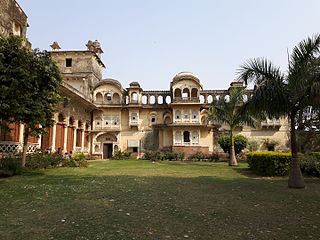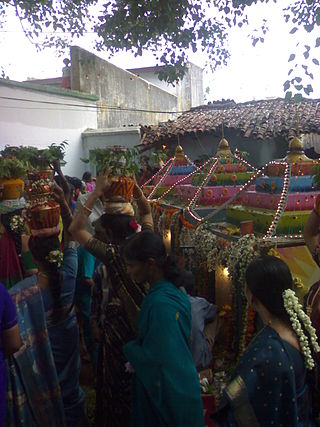
Yakshagana is a traditional theatre, developed in Dakshina Kannada, Udupi, Uttara Kannada, Shimoga and western parts of Chikmagalur districts, in the state of Karnataka and in Kasaragod district in Kerala that combines dance, music, dialogue, costume, make-up, and stage techniques with a unique style and form. It is believed to have evolved from pre-classical music and theatre during the period of the Bhakti movement. It is sometimes simply called "Aata" or āṭa. This theatre style is mainly found in coastal regions of Karnataka in various forms. Towards the south from Dakshina Kannada to Kasaragod of Tulu Nadu region, the form of Yakshagana is called Thenku thittu and towards the north from Udupi up to Uttara Kannada it is called Badaga thittu. Both of these forms are equally played all over the region.(Not sure about this one but) Yakshagana is traditionally presented from dusk to dawn. Its stories are drawn from Ramayana, Mahabharata, Bhagavata and other epics from both Hindu and Jain and other ancient Indic traditions.

Girish Karnad was an Indian actor, film director, Kannada writer, playwright and a Jnanpith awardee, who predominantly worked in Kannada, Hindi, Tamil, Telugu, Malayalam and Marathi films. His rise as a playwright in the 1960s marked the coming of age of modern Indian playwriting in Kannada, just as Badal Sarkar did in Bengali, Vijay Tendulkar in Marathi, and Mohan Rakesh in Hindi. He was a recipient of the 1998 Jnanpith Award, the highest literary honour conferred in India.
Arebhashe or Aregannada or Gowda Kannada is a dialect of Kannada mainly by Gowda communities in the region Madikeri, Somwarpet, and Kushalnagar taluks of Kodagu district, Sullia, taluks of Dakshina Kannada district; Bangalore and Mysore districts in the Indian state of Karnataka. As well as Bandadka, Kasaragod District in the Indian state of Kerala, Arebhashe is also called Gowda Kannada. The language was recognized by the Karnataka State government and formed an academy in 2011 to preserve the culture and literature of the Arebhahse Region which is named as Karnataka Arebhashe Samskruthi mathu Sahitya Academy supported by then Chief Minister D. V. Sadananda Gowda.

The Manipuri Dance, also referred to as the ManipuriRaas Leela, is a jagoi and is one of the eight major Indian classical dance forms, originating from the state of Manipur. The dance form is imbued with the devotional themes of Madhura Raas of Radha-Krishna and characterised by gentle eyes and soft peaceful body movements. The facial expressions are peaceful mostly expressing Bhakti Rasa or the emotion of devotion, no matter if a dancer is Hindu or not. The dance form is based on Hindu scriptures of Vaishnavism and is exclusively attached to the worship of Radha and Krishna. It is a portrayal of the dance of divine love of Lord Krishna with goddess Radha and the cowherd damsels of Vrindavan, famously known as the Raas Leela.

Sheopur is a city in Madhya Pradesh state of central India. It is the administrative headquarters of Sheopur District. Sheopur is linked by narrow gauge rail to Gwalior(No longer in operation). The town is traditionally famous for its wood carving. Chambal River is just 25 km, which forms the boundary between Rajasthan and MP states.

Malavalli Huchchegowda Amarnath, known by his screen name Ambareesh, was an Indian actor, media personality, politician from the state of Karnataka. Alongside Rajkumar and Vishnuvardhan, he is counted in Kannada cinema's "triumvirate" as its most celebrated actor.

The Beary are a community concentrated along the southwest coast of India, mostly in the Mangalore district of the south Indian state of Karnataka.
The dance forms of Andhra Pradesh take on a wide variety of colors, costumes, and types; and involve different settings and musical instruments.

Būta Kōlā, also referred to as Daiva Kōlā or Daiva Nēmā, is a shamanistic dance performance prevalent among the Hindus of Tulu Nadu and parts of Malenadu of Karnataka and Kasargod in northern Kerala, India. The dance is highly stylized and performed as part of 'Bhootaradhane' or worship of the local deities worshipped by the Tulu speaking population. It has influenced Yakshagana folk theatre. Būta kōlā is closely related to Theyyam of North Malabar region.

Bonalu( Telugu: బోనాలు) is a traditional Hindu festival centered on the Goddess Mahakali from Telangana. This festival is celebrated annually in the twin cities of Hyderabad and Secunderabad, as well as in other parts of the state. It is celebrated in the month of Ashada Masam, which is around July and/or August. Special "poojas" are performed for Yellamma on the first and last day of the festival. The festival is also considered a thanksgiving to the Goddess for fulfillment of vows.

Karnataka has a variety of traditional arts, including folk dance and puppetry.

Dance in Burma can be divided into dramatic, folk and village, and nat dances, each having distinct characteristics. Although Burmese dance resemble the traditional dancing style of its neighbors, in particular [Dance in Cambodia ], it retains unique qualities that distinguish it from other regional styles, including angular, fast-paced and energetic movements and emphasis on pose, not movement.
Mangaloreans are a collection of diverse ethnic groups that hail from the historical locales of South Canara (Tulunaad) on the south western coast of Karnataka, India, particularly the residents native to Mangaluru.
Bengaluru Karaga is an annual festival celebrated in the Halasuru Pete which is also known by Tigalare Pete, primarily by the Vahnikula Kshatriya community. Based on their heritage story, they built temples to Draupadi and Dharmaraya. Adishakti Draupadi is the community Deity of the Vahnikula Kshatriyas, one of the foremost communities in Karanataka state. The Dharmaraya Swamy Temple itself is more than 800 years old. It was built by the Vahnikula Kshatriyas, one of the city's oldest communities that was into agriculture and horticulture. The Karaga festival is generally led by the Vahnikula Kshatriyas. Karaga is one of the many traditions of worshiping Adisakti Draupadi Devi. Karaga pooja and festivals have been celebrated in Tamil Nadu and Karnataka since ages. Its practice is in use in some parts of Kolar district and Bangalore in the state of Karnataka. It is learnt that there are forty lakh people belonging to the Vahnikula Kshatriya community living throughout the state: Hoskote, Malur, Kolar, Bengaluru and Anekal taluks have high populations of the Vahnikula Kshatriya community in both urban and rural areas. Basically, this community depends upon agricultural and horticultural activities.
Theeyaattam also known as Theeyaattu (Tīyāttu) is a traditional temple dance form of Kerala.

Gotipua is a traditional dance form in the state of Odisha, India, and the precursor of Odissi classical dance. It has been performed in Orissa for centuries by young boys, who dress as women to praise Jagannath and Krishna. The dance is executed by a group of boys who perform acrobatic figures inspired by the life of Radha and Krishna. The boys begin to learn the dance at an early age until adolescence, when their androgynous appearance changes. In the Odia language, Gotipua means "single boy" (goti-pua). Raghurajpur, Odisha is a historic village known for its Gotipua dance troupes. The dance of the Gotipuas is accompanied by traditional Odissi music with the primary percussion being the Mardala.
Tulu Gowda and Arebhashe Gowda (Gauda) are primarily found in South Canara District, Kodagu District, Indian state of Karnataka and Bandadka village of Kasaragod. They are a subsect of the Vokkaliga community but are culturally and linguistically different. They speak Tulu and Arebhashe.

Ramman is a religious festival and ritual theatre of the Garhwal region in India. It is a festival of the Garhwali People in the Saloor Dungra village of the Painkhanda Valley in the Chamoli district in Uttarakhand, India.
Chennu Nalike is an ancient traditional folk art form practised by Tulu people from the region of Tulu Nadu, India. This performing after the harvesting, in the month of suggi, is one of the month in Tulu calendar. It normally comes in the months of February and March.

Nayadikali is a traditional folk art form that exists among the Panan community of the Valluvanad region in Kerala, India. It is usually performed ahead of the Pooram festival at the Devi temples in the region, for the good and prosperity of the people and region.












